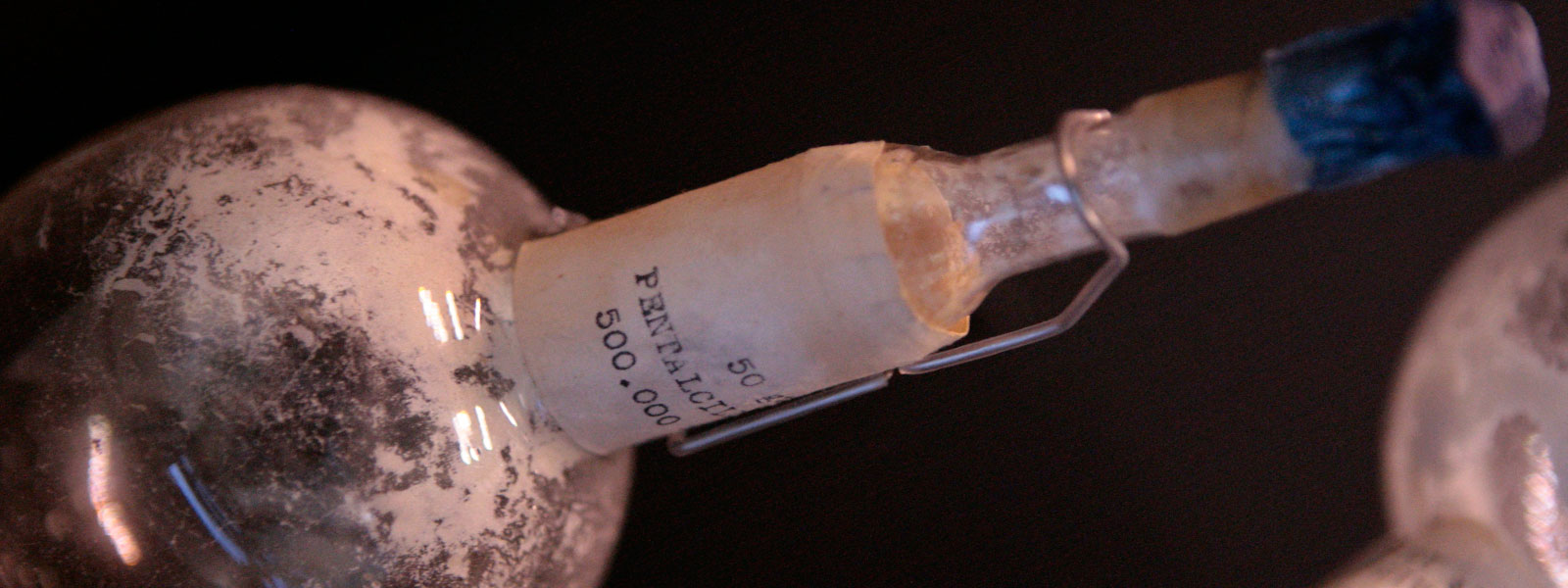Pentalcilina
A product which boosted the power of penicillin
Technical file
Type of innovation: Penicillin
Scope: Biomedicine
Innovation leader: Grifols i Roig, Josep Antoni; Grifols i Lucas, Víctor
Year: 1944
Period: 1909-1971
Geographical scope: International
Economic impact: Low
Level of innovation: Adaptive
Patent: Yes
Interdisciplinary connections: -
As the incredible power of penicillin to fight bacterial infections became clear in the 1940s, so did the battle to mass produce this strategically important medicine, while the Second World War raged.
Ensuring supplies of a powerful medicine
By the end of the conflict, only the United States had succeeded in stockpiling large quantities of penicillin and held 95 percent of the world's entire stocks. Other countries were frantically looking at how they could secure their own supplies of the drug to avoid dependence on other nations. In Spain, the isolationist policies of fascist dictator Francisco Franco meant that having a reliable supply was an even more urgent priority.
Josep Antoni Grifols i Roig was one of several doctors in Spain engaged in the quest. He collaborated with the Sociedad General de Farmacia, which under the name OM Laboratories, registered the first penicillin preparation in Spain a year later, as injectable Penicillin OM. This product was manufactured at its Swiss plant and imported for use in Spain.
“An increase of 50 to 60 percent in penicillin's power to inhibit bacterial growth was achieved by combining the drug with sulfonamides”
Even greater potential to cure
But the Grifols family involvement in penicillin didn't end there. Ever keen to innovate and improve, Dr. Víctor Grifols i Lucas travelled to London to obtain the latest scientific knowledge about large-scale production of the drug.
After his return, further collaboration with the Sociedad General de Farmacia yielded a powerful innovation for penicillin that would improve the drug's potency, and its value to patients. An increase of 50 to 60 percent in penicillin's power to inhibit bacterial growth was achieved by combining the drug with sulfonamides. The new innovation was marketed under the name of Pentalcillin, and first went on sale on May 28, 1948.
Lack of space and time at Laboratorios Grifols meant the company could not fully capitalize on its new product. And Franco regime's restriction of national production of penicillin to only two organizations put a final end to Pentalcillin a few years later.

Landmarks in the development of penicillin
The history of science is not made exclusively by its great names, as the story of penicillin illustrates.
There is evidence that ancient cultures including the Babylonian, Greek and Indian civilizations had already identified the natural properties of some molds to curb bacteriological infections.
At the end of the 19th century, many scientists began to study the antibiotic power of a specific type of fungus: penicillium. Lister, Roberts, Tyndall, Pasteur and Duchesne showed that their different variants reduced bacteriological growth in some way.
By the 1920s, Gratia, Dath and Picado had indicated their effectiveness in inhibiting growth in staphylococcus cultures, but it was not until 1928 that Alexander Fleming named the molecule produced by the fungus penicillin, and demonstrated its antibiotic power in vitro.
However, for more than 10 years his findings would have little impact, since Fleming could not purify or isolate the molecule. Neither could he make it stable enough to mass-produce antibiotics, and thus meet the needs generated by World War Two.
It was Ernst Chain, Howard Florey and Norman Heatley who, through a collaboration between Great Britain and the USA during the 1940s, managed to demonstrate penicillin's effects in vivo, as well as to purify enough to be used during the war, inaugurating the era of antibiotics.
In 1945, Fleming, Florey and Chain were awarded the Nobel Prize in Medicine for their inspired and world-changing efforts.
Bibliography
Saenz, H. (1944, March 12). Hace casi dos años que la famosa droga se obtiene en Barcelona, en donde se utiliza con resultados satisfactorios. La Vanguardia Española, 5.
Grifols-Lucas, V. (1946). Memoria sobre el viaje a Inglaterra realizado por Víctor Grífols del 12 de Julio a 22 de Agosto de 1946. Unpublished manuscript. Barcelona: Hemobanco de Laboratorios Grifols, S.A.
Landsberg, H. (1949). Prelude to the Discovery of Penicillin. Isis, 40(3), 225-227.
Wainwright, M., & Swan, H.T. (1986). C.G. Paine and the earliest surviving clinical records of penicillin therapy. Medical History, 30(1), 42-56.
American Chemical Society. (1999). Discovery and Development of Penicillin. London: The Alexander Fleming Laboratory Museum.
Grifols-Lucas, V. (2009). Amb un suro i un cordill. Vivències d'un empresari de postguerra. Barcelona: Grupo Grifols, S.A.
Romero de Pablos, A. (2011). Regulation and the circulation of knowledge: Penicillin patents in Spain. Dynamis, 31(2), 363-383.
González-Bueno, A., & Rodríguez-Nozal, R., & Pérez-Teijón, C.J. (2012). La penicilina en España: difusión, propiedad industrial y negocio, en clave autárquica (1944-1959). Revista Estudos do Século XX, 12, 271-287.
Markel, H. (2013, Septiembre 27). The real story behind penicillin. Retrieved from https://www.pbs.org/newshour
Avellà, R., & Miquel, B. (Eds.). (2015). Cuando un sueño se cumple. Crónica ilustrada de 75 años de Grifols. Barcelona: Grupo Grifols, S.A.
González-Bueno, A., & Rodríguez-Nozal, R., & Pérez-Teijón, C.J. (2017). Social, technical and economic aspects related to the introduction of penicillin in Spain (1944-1959). Anales de la Real Academia Nacional de Farmacia, 83(4), 421-432.
Lobanovska, M., & Pilla, G. (2017). Penicillin's Discovery and Antibiotic Resistance: Lessons for the Future?. Yale Journal of Biology and Medicine, 90(1), 135-145.